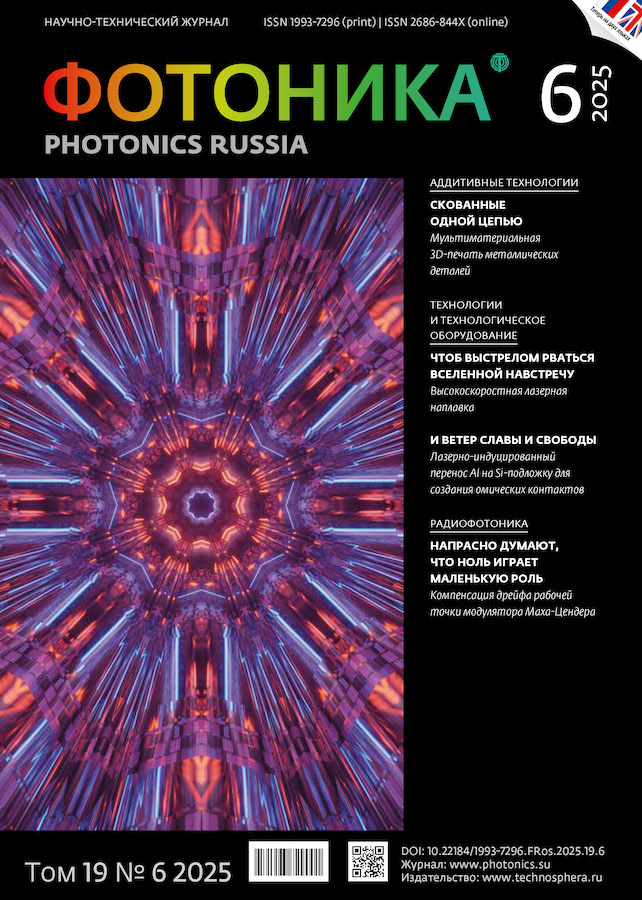Том 19, № 6 (2025)
- Год: 2025
- Статей: 7
- URL: https://journals.eco-vector.com/1993-7296/issue/view/14181
- DOI: https://doi.org/10.22184/1993-7296.FRos.2025.19.6
Аддитивные технологии
Мультиматериальная 3D-печать: роль синтеза на подложке
Аннотация
Мультиматериальная 3D-печать методом синтеза на подложке (СНП) представляет перспективный подход для создания изделий с локально варьируемыми свойствами. Однако технологические ограничения, связанные с различиями в физико-химических свойствах соединяемых материалов, и отсутствие системной классификации затрудняют развитие данной области. Разработана новая классификация мультиматериалов для СНП, которая включает три группы – однородные сплавы (на основе одного металла), разнородные свариваемые сплавы, разнородные несвариваемые сплавы. Исследованы особенности переходных зон для семи систем (ВТ6/ВТ1-0, AlSi10Mg/Al-Si-Mg-Cu, 316L/FeNi36, ВЖ159/БрХЦрТ В, Ti6Al4V/Inconel 718, 316L/NiTi). Установлено, что количество дефектов, микроструктура и фазовый состав переходной зоны определяются типом комбинации сплавов. Разработанная классификация позволяет систематизировать исследования, оптимизировать параметры печати, в том числе лазерных инструментов, и прогнозировать возможность возникновения проблем при создании новых мультиматериальных систем.
 428-442
428-442


Технологии и технологическое оборудование
Уплотнение сверхтугоплавкой карбидной керамики с помощью лазерного переплава для лазерно-индуцированной масс-спектрометрии
Аннотация
Представлена методика модификации поверхностного слоя образцов из смешанного карбида тантала–гафния для получения образцов с предельно высокой плотностью, необходимых для уверенной реализации экспериментов по масс-спектрометрии пара, образующегося при лазерно-индуцированном испарении. Получение таких образцов проводилось путем переплава поверхностного слоя керамики из карбида тантала–гафния с использованием серии субсекундных лазерных импульсов. Анализ полученных областей переплава показал, что область закристаллизованного расплава представляет собой однофазный смешанный карбид – твердый раствор системы HfC–TaC, который характеризуется высокой однородностью распределения тантала и гафния во всей переплавленной области. С помощью времяпролетной масс-спектрометрии была изучена эволюция компонентов пара при лазерно-индуцированном испарении предварительно переплавленного карбида, которая показала хорошую корреляцию с температурой поверхности в отличие от экспериментов с исходной керамикой.
 444-453
444-453


Высокоскоростная лазерная наплавка штоков гидравлических цилиндров
Аннотация
В ходе проведения работ выполнены исследования образцов, полученных с применением технологии высокоскоростной лазерной наплавки поверхности с использованием волоконных лазеров компании ООО «ВПГ Лазеруан». Рассмотренный способ обработки является перспективным методом нанесения защитных покрытий на поверхности металлов. В статье изложены результаты работ по нанесению покрытий на среднеуглеродистую сталь 38Х2МЮА высоколегированными порошковыми материалами на железной основе. В результате получен поверхностный слой с повышенными значениями микротвердости и износостойкости. Высокая скорость процесса позволила минимизировать нагрев образцов, что приводило к сохранению его исходных геометрических размеров, а также минимальному перемешиванию наплавляемого материала с основой при высокой прочности сцепления покрытия с металлом основы.
 454-464
454-464


Одноимпульсный лазерно-индуцированный перенос Al на подложку Si для создания омических контактов
Аннотация
В статье исследованы алюминиевые контакты на кремниевых подложках, созданные методом лазерно-индуцированного переноса. Установлено, что при одноимпульсном режиме экспонирования в точку поверхности и плотности энергии 15 Дж / см2 достигается концентрация алюминия 18,6% и минимальное контактное сопротивление 439 ± 4 Ом. Метод упрощает процесс формирования контакта и исключает необходимость в сложной очистке, что делает его перспективным для будущих электронных приложений на основе кремния.
 466-477
466-477


Радиофотоника
Метод компенсации дрейфа рабочей точки модулятора Маха-Цендера с помощью электрической схемы на основе терморезисторов
Аннотация
Модуляторы Маха-Цендера на основе объемного или тонкопленочного ниобата лития являются ключевыми компонентами сетей передачи данных, включая квантовые коммуникации. Однако проблема дрейфа рабочей точки по-прежнему актуальна. Ранее было продемонстрировано множество методов компенсации дрейфа рабочей точки для решения различных технических задач. В данной работе мы предлагаем аналоговую электрическую схему термокомпенсации дрейфа рабочей точки с использованием терморезисторов. Мы демонстрируем сначала настройку электрической схемы от температуры, а затем экспериментально подтверждаем эффективность этого метода, получая максимальное отклонение от средней оптической мощности не более 1,0 дБ или 1,0 В, приложенного постоянного напряжения при температуре до 45 °C. Предложенный подход не требует дополнительного источника питания и может быть использован для специальных задач в удаленных локациях.
 478-485
478-485


Волоконно-оптические устройства и технологии
Утечка речевой информации через волоконно-оптические технические каналы офиса: борьба с шумами (шумоподавление)
Аннотация
Эффективность функционирования и нейтрализации каналов утечки речевой информации через волоконно-оптические коммуникации во многом определяется зашумлением оптического канала в структурированных кабельных системах объекта. Адаптирование известных методов борьбы с шумами в волоконно-оптических каналах утечки речевой информации позволяет значительно повысить отношение сигнал/шум и, следовательно, эффективность перехвата. В частности, волоконно-оптическую подсистему в структурированных кабельных системах объекта с распределенными измерительными свойствами можно представить в виде фазированной акустической волоконно-оптической решетки и, применяя метод накопления при многоканальном измерении, провести выделение информативного сигнала на фоне шума. Еще один метод борьбы с шумами состоит в сравнении двух несимметричных по акустической чувствительности оптических каналов (дифференциальный метод), что возможно осуществить вследствие размещения в кабельных каналах объектов дуплексных кабелей. Дифференциальный метод шумоподавления проверен на модельной установке по исследованию канала утечки речевой информации, который показал существенное повышение отношения сигнал/шум даже на малых длинах кабеля. Реализация дифференциального метода возможна вследствие коррелированности низкочастотного зашумления оптического канала в течение длительного времени (0,1 мсек) и значительного светового пути в оптоволокне (20 км). Представленные теоретические и практические исследования показывают высокий уровень опасности акустических волоконно-оптических каналов утечки речевой информации и возможностям противодействия им.
 486-499
486-499


Материалы и покрытия
Биметаллические тетрафтортерефталаты тербия и европия с фенантролином: фотостабильность и применение в термометрии
Аннотация
Исследованы люминесцентные комплексы тербия и европия с тетрафтортерефталевой кислотой и фенантролином для применения в термометрии. Показано, что в отличие от смеси индивидуальных комплексов, демонстрирующих различную скорость фотодеградации, биметаллический комплекс сохраняет стабильное соотношение интенсивностей полос излучения Tb3+ и Eu3+ при общем снижении интенсивности люминесценции. Разработаны композитные материалы на основе синтезированных комплексов в полиимидных и полистирольных матрицах, сочетающие термочувствительные свойства с механической устойчивостью. Полученные результаты открывают перспективы создания стабильных люминесцентных термометров для биологических и микроэлектронных применений.
 500-508
500-508








